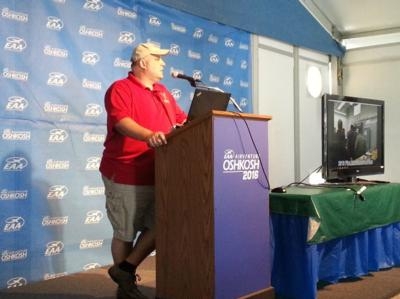Thu, Jul 28, 2016
Presents Update On Milestones Reached At AirVenture
By Anthony Liberatore
Since their first news conference at AirVenture last year, Engineered Propulsion Systems (EPS) has reached several significant milestones on their path towards certification of their Diesel engine.

EPS Co-founder, CEO, and President Michael Fuchs said in a news conference Tuesday that the company has made progress towards both Type (TC) and Production Certification (PC) as well as serial production. Fuchs noted the target date for obtaining a Type Certificate is late 2017, with the PC shortly their after. The EPS Engine is a “Flat Vee” (15º) V8 Heavy Fuel Engine in the 300 to 420 hp class, with fuel consumption specifics that are 30% lower than their Piston competitors and 50% lower than their Turboprop competitors.
Among the milestones noted by Fuchs for 2016 are that the conformity process has proceeded to the point that all engine parts and systems are confirmed. He also noted they have completed their second Propeller Survey with Hartzell Propeller at their Ohio facility. Fuchs also noted that EPS Diesel with be certified for both Composite and Metal Propellers. Early on in EPS's development cycle, EPS met with potential customers from diverse backgrounds such as Missionary Aircraft and Seaplanes to understand what type of propellers were needed for their applications.
Fuchs said the company has ramped up personnel to assist in their efforts towards obtaining their TC and PC, including direct hires, sub-contractors, and those affiliated with their Diesel Injection / ECU system sub-supplier Bosch. At this time, 100 people are working towards both certifications, with the majority of the employees working under the Bosch umbrella.
Fuchs discussed a number of interesting facts about the engine. One is that while it is a 15º V8, the footprint of the engine is that of a traditional flat six cylinder aircraft engine. Another is while it is Liquid Cooled Diesel, there are not aviation fluids available for both systems. However, the engine will utilize the conventional 50/50 coolant and water mix for the liquid cooling system and a heavy duty Diesel truck oil for its lubrication. Fuchs was asked about testing the engine's ECU against potential lightning strikes, and he said the company is working towards meeting DO-160G, FAR 23, and FAR 27 requirements for the ECU.
(Staff image)
More News
Also: New Lakeland Fly-in!, Gleim's DPE, MOSAIC! Nearly three-quarters of a century in the making, EAA is excited about the future… especially with the potential of a MOSAIC>[...]
Estimated (EST) -When used in NOTAMs “EST” is a contraction that is used by the issuing authority only when the condition is expected to return to service prior to the >[...]
Aero Linx: Regional Airline Association (RAA) Regional airlines provide critical links connecting communities throughout North America to the national and international air transpo>[...]
The Airplane Broke Up In Flight And Descended To The Ground. The Debris Path Extended For About 1,435 Ft. Analysis: The pilot, who was the owner and builder of the experimental, am>[...]
From 2015 (YouTube version): History Comes Alive Thanks to A Magnificent CAF Effort The story of the Douglas C-47 named, “That’s all Brother,” is fascinating from>[...]
 Airborne 07.21.25: Nighthawk!, Hartzell Expands, Deltahawk 350HP!
Airborne 07.21.25: Nighthawk!, Hartzell Expands, Deltahawk 350HP! ANN's Daily Aero-Term (07.27.25): Estimated (EST)
ANN's Daily Aero-Term (07.27.25): Estimated (EST) ANN's Daily Aero-Linx (07.27.25)
ANN's Daily Aero-Linx (07.27.25) NTSB Final Report: Luce Buttercup
NTSB Final Report: Luce Buttercup Classic Aero-TV: 'That's All Brother'-Restoring a True Piece of Military History
Classic Aero-TV: 'That's All Brother'-Restoring a True Piece of Military History



